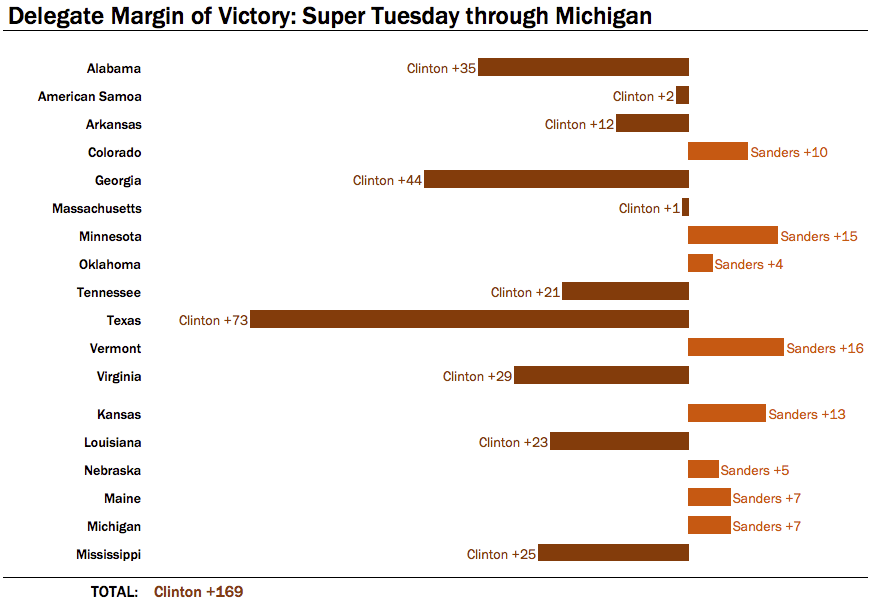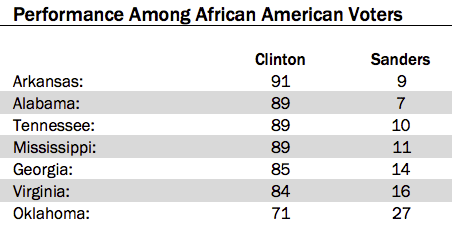Is Bernie Sanders’ Win in Michigan the First Crack in the Clinton Firewall?
After Tuesday night, here’s where Sanders stands in the delegate race.
Christopher Hass

How super was Super Tuesday for Hillary Clinton, and how big was Bernie Sanders’ upset victory in Michigan? The past eight days have shown the strengths and limitations of the two campaigns, and brought into focus the contours of the 2016 Democratic electorate. Clinton has racked up an overall lead of more than 200 pledged delegates, but as the race moves to a series of states more favorable to Sanders, the question becomes whether or not he can close the gap.
In February, I outlined a hypothetical path to victory for Sanders in which he won the Democratic nomination by a single delegate. My point was that, counter to the mainstream media narrative, it’s delegates and not states — or superdelegates — that will ultimately determine the Democratic nominee. Here then is a state-by-state look at the margin of victory among pledged delegates, from Super Tuesday through last night’s Michigan and Mississippi primaries:

* Delegate counts are based on the latest reported totals when this article went to press.
Bernie’s Big Five
Going in to Super Tuesday, the Sanders campaign focused its attention on five states that each had some combination of factors favorable to him: caucuses, large progressive populations or a predominantly white working class. Sanders won four outright (Vermont, Colorado, Minnesota and Oklahoma) and lost the fifth (Massachusetts) by less than 2 percent. Those four wins netted Sanders 45 delegates, but the bigger challenge was keeping his losses close. That didn’t happen.
The Southern firewall held
Clinton’s margins of victory were much bigger, in bigger states. The biggest challenge for Sanders so far has been Clinton’s ability to run up the score among black voters — in Mississippi, her overall delegate margin of victory was more than three times what Sanders gained in Michigan.
Not only has Clinton been able to match Barack Obama’s performance among African American voters in 2008, in many places she’s managed to beat it. Only in Oklahoma (a state he won) was Sanders able to break 20 percent among African Americans. And while Sanders has continued to dominate among young voters, on Super Tuesday, African Americans made up a much larger proportion of voters than millennials.

This right here is the vaunted Clinton “firewall” in the South. African American voters aren’t just stopping Sanders’ momentum, they’re driving Clinton’s victory.
The Michigan surprise
FiveThirtyEight.com described Sanders’s win in Michigan as “one of the greatest upsets in modern political history.” Polling averages had Clinton leading by nearly 22 points, but Sanders pulled out an 18,000 vote victory. But even more importantly, for the first time Sanders made inroads with large numbers of black voters, winning 28 percent of the African-American vote — just enough to eke out a slight, one percent victory overall. As the primary moves out of the South, Sanders’ best hope is that Michigan is a bellwether for what’s to come.
March 22: Mark your calendar
In total, since Super Tuesday Clinton has won 10 states, with an average margin of 27 delegates; Sanders has won eight, with an average margin of just under 10 delegates each. Make no mistake, Clinton’s overall lead of 200-plus delegates will be incredibly difficult for Sanders to overcome. In 2008, Barack Obama was able to take advantage of numerous missteps by the Clinton campaign that added to his delegate total and ultimately pushed him over the top.
This time around, the Clinton campaign is running a much better campaign, and their investment in organizing has kept the margins closer even in her loses. But the greatest barrier right now is Sanders’ inability to reach African Americans and, to a lesser extent, Latinos. He has built an impressive coalition of young people (both men and women), but the limits of that coalition — and its lack of diversity — are making the math increasingly difficult for him.
For Sanders, the most favorable run of states begins on March 22, and it’s there that he’ll have his first and best chance to close the gap. Between March 22 and May 10, Sanders could keep things close or win outright in 14 of 17 contests: Arizona, Idaho, Utah, Alaska, Hawaii, Washington, Wisconsin, Wyoming, Connecticut, Delaware, Rhode Island, Indiana, Guam and West Virginia. Whether or not Michigan proves to be a predictor or an outlier could make all the difference.
This is the second in an ongoing series on the delegate race for the Democratic nomination. Sign up here to make sure you don’t miss any upcoming installments.
Christopher Hass was Executive Publisher of In These Times from 2016 through 2021, and interim Publisher in 2022. Before joining ITT, he spent eight years working on political and advocacy campaigns, including both the 2008 and 2012 Barack Obama presidential campaigns. He is also the former editor and publisher of P8NT Magazine.








